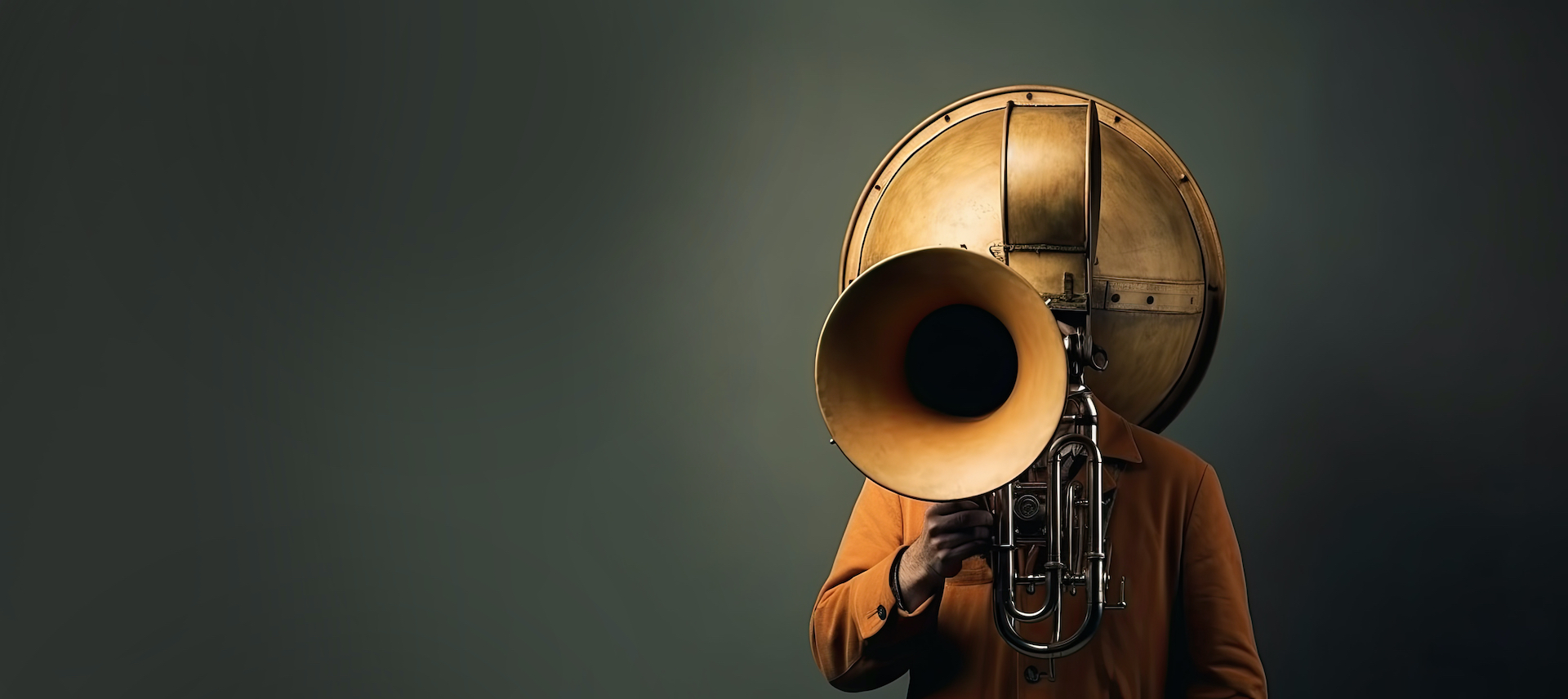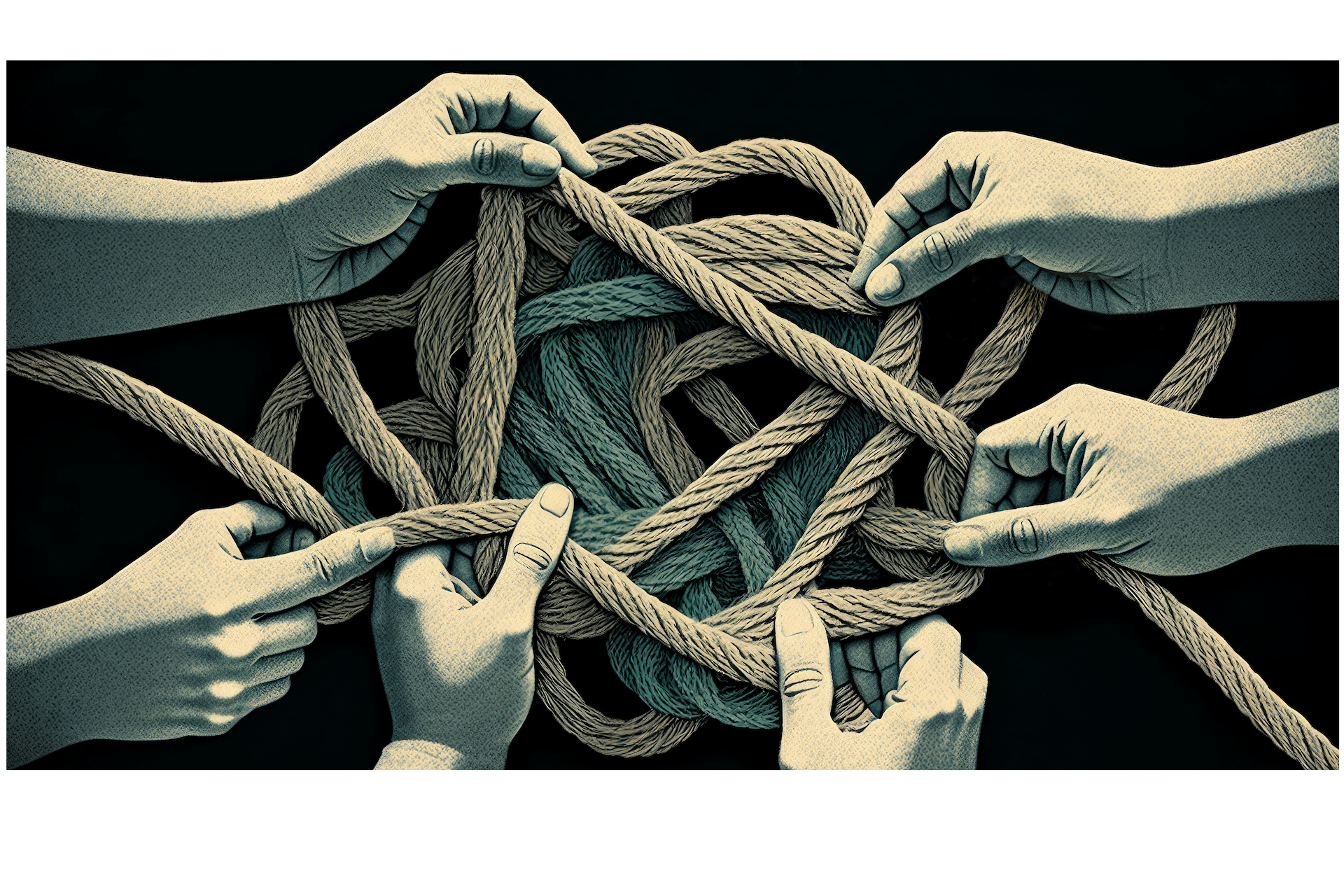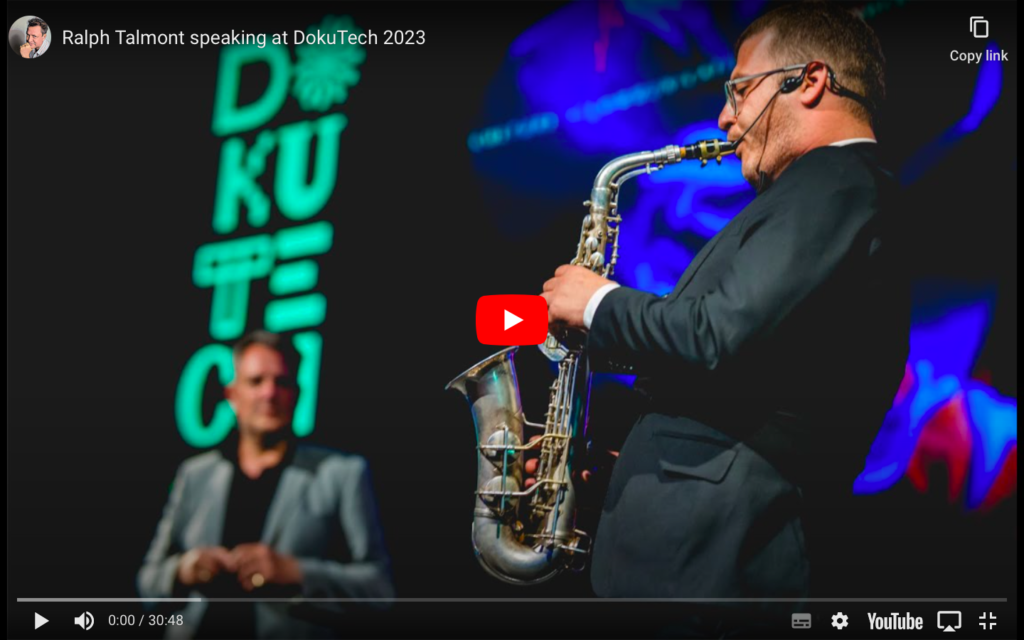
04 Jul Human connection in the age of machines (and the role of artists in this)
My friend Kushtrim Xhakli and I tried to coordinate our diaries a few times before to allow me to speak at his excellent DokuTech gathering in Pristina (Kosovo.) Finally, we managed it. Here is a transcript of my talk, the main point of which was that in the age of machine intelligence, humans need to work together – not against pervasive technology but in order to figure out how to best work with it – and artists point the way to doing this as a matter of practice. A length of rope – passed around the room – served as a prop. The wonderful Dukagjin Muhaxheri added some vital flourishes on his alto.
The link to the video is a little down this page.

Here’s a provocative little statement: in the future, the real and the authentic and the human will have premium value.
Do you agree? Do we agree that somehow there is inherent high value in stuff made by people? More so that stuff that’s made by machines? It’s a sweeping statement, I know, but I only have twenty minutes here so allow me some shortcuts!
Actually, that’s not quite right. The real, the authentic and the human already have premium value, and have done so for a very long time. In the future, that value will just increase, probably exponentially, as most commonplace things get commoditised.
My oldest friend on this green Earth is an Australian photographer by the name of Emmanuel Santos. Back in the day, when we were both young fellas, I went off into commercial and editorial photography while Emmanuel has stuck to making a living from the sale of prints and portfolios. Now, forty years later, Emmanuel keeps producing beautiful work and keeps satisfying the passions of collectors in Europe, Asia, Australia and elsewhere. Meanwhile, I have reinvented myself professionally four times in the last twenty years. I’ve not shot any commercial work for ten years, as the digital revolution turned the market upside down and made it unviable for many working professionals to stay in that business.
My world is the broadly understood creative industry which has been through an incredible transformation. Now it seems we are just entering the next phase, where we will define the nature of creativity itself, and how human creativity, aided by powerful technology, will pull and stretch meaning of the word itself well beyond what we had been used to.
I have no idea what our world will look like in a decade. It’s not hard to imagine, however, what it will look like if we don’t look after the human element. Dystopia has many potential forms but one common denominator: if we don’t pay attention to the human, we get dehumanised by the process, by default.
So I’m here to talk about the all important human connections and how those are good for us individually, and good for us on a community level. And about the expanding role of artists in all of this excitement. And how keeping things authentic and human will be good for business.
We love analogue, human-made things even if we’re not necessarily aware of the reasons. Sales of vinyl have been growing rapidly for more than a decade, and not just to nostalgic boomers like me. Sales of things made in someone’s workshop – handicrafts and objects made by professional craftspeople – are doing well, both in the real world and online.
Hand-made jewellery, furniture and chef’s knives are prized possessions. Of course, anything can be made as a cheaper copy but I love my hand-made damascene steel knives and wouldn’t trade them for anything. Actually, I’m rather convinced that, pretty soon, we will have a labelling system in place. Something along the lines of “Human-made”.
We will have labelling of objects and experiences to set them apart from those not made by people. This will start as a social movement, build into pressure groups, and then in short order be written into regulation – in those countries where people matter, of course. We will see labels establishing the human-made provenance of objects and experiences, and proving their special value.
Why? That question itself is fascinating – why would we prefer one thing over another, simply because it is made by humans, if both look more or less the same and have the same function? As I will say a few times today, there’s research that says, we love the connection we feel with the makers of a thing made with care and attention.
So we’re here to talk about human connections and new ideas, and keeping things real. So let’s talk about unexpected ideas. Who loves surprises?
We love the unexpected and the surprising. It’s good to know that surprise is an important building block of everything we take in under the general umbrella of creativity and innovation.
New ideas come from new connections between ideas. Much like when a musician composes a new piece or improvises on the spot – hi (Name) – she has a set number of notes at her disposal. The intervals, the pauses, the arpeggios, all are building blocks that are hers to use, and to create something new, all she has to do is line them up in a new order. That, of course, only sounds simple. Incidentally, we have a set number of thoughts every day, and most of them are exactly the same, day in, day out. Not ideal if we want to keep generating new ideas.

I work with a neuroscientist on one of my projects, and she tells me that there are any number of studies that have demonstrated, elegantly, that new ideas are recombinations of existing ideas in ways we hadn’t thought of before. Those may be our own ideas, or someone else’s, of course. What works really well, is random input from unexpected directions. All you have to do is be open to it, as a matter of practice. Random words, for example, are in fact a very effective thinking tool. So, of course, is input from strangers.
So here’s a thought. When was the last time you talked – really talked – to someone from outside of your own bubble? Not just chitchat or business networking that has a few simple goals. But delved into a conversation of what really makes you tick, and how you might be able to help each other in ways that may not be immediately obvious.
Staying in bubbles of course has an air of comfort and familiarity but those are qualities we cannot rely on any more. Comfort and familiarity lead to a reduction of horizons, not an expansion of them. Columbus did not head out over the horizon because he wanted to stay comfortable. Actually, he wanted to get rich. That’s another story.
So this is our experiment. We have been passing the end of this rope around the room. Please keep passing it, while hanging on to it. The rope has a finite length – we’re not going to tie everyone up in knots. I’ll hang on to the bitter end (that’s a nautical term, by the way) and will tell you what it’s all for when we’re done. OK? Up for a game? Good.
Connecting with strangers and getting inspired by them is standard operating procedure for a category of human from whom the rest of humanity has, and can continue to learn about creativity in everyday life. They connect with others to come up with new ways of seeing things. That category is of course artists. And artists have a lot more to give than just their art. They operate according to different rules and on different frequencies. Sometimes stereotypically so. We know this, right?
Now it just so happens that business has been waking up to the fact that creativity is a good a valuable thing and employees should have more of it. All of these articles incidentally, as well meaning as they are, are missing the main bloody point. Creativity is not a skill. It is the soil from which skills grow. But be that as it may.
So, what they usually do is bring in me or someone like me, to run a creative thinking workshop. Which is all well and good – the people have fun, they enjoy the new mental connections they make on the inside, and the human connections on the outside, I get paid, but it usually turns out that such short term engagements really do not move the creativity needle long term.
So what does the company do? They run another creative thinking workshop the next year, once the L&D cycle has come around again. This happens not because the people who run those businesses are dumb but because they’re acting according to an established script. Soft skill training in February, hard skills through the Spring and then a nice creative thinking workshop just before the Summer holidays.
None of that makes sense in today’s world. Acting according to scripts set up years ago by well-meaning HR directors, and fulfilled conscientiously ever since, no longer makes sense. Creative thinking of people needs more than a creative thinking workshop. It needs a makeover, in order to get dramatically different results.
Makeovers require bravery, and bravery doesn’t say “oh we’ll run another creative thinking workshop because that’s what fits into the annual programme.” The annual programme needs changing. And as we have seen, who are the people from whom we can learn about change and about brave, different, new thinking? That’s right, artists.
By accessing the raw imagination power of artists we are able to envision aspects of business, and of life, that escape traditional practices. The mental process required to imagine situations, run scenarios and quickly assess options is the daily practice of creative professionals. Meanwhile, the “future of work” has been an area under constant examination and development for a long time, but, unfortunately, much of the effort has been expended from the perspective of logic, analysis and deduction – which is what business does naturally. It’s designed to do that.
In today’s VUCA world – in this world that is volatile, uncertain, complex and ambiguous, deduction is not enough, and if people continue to search for solutions through reason alone they will be disappointed. We need to rely a lot more on the powers of induction, imagination and creative exploration – and we need to learn how to do that as fast as we can, so we need to learn together, with and from each-other. Kids do that naturally, right? We need to be more like kids.
Importantly, we should be learning from people you’ve never met, whose thoughts are not like your thoughts. And who are the best teachers of imagination and creative exploration? Right again, artists, musicians, performers.
We can assume that within a few short years we will be using AI like we use other tech. Seamlessly and without giving it much of a thought as interfaces built for specific jobs do the interfacing between us and AI. And of course, those of us who are best at figuring out how to work with these things will advance furthest, fastest. AI will compress the time it takes to succeed, and of course it will also compress the time it takes to fail.
This is a simplification but, considering the general level of concern out there, we may now be tempted to think that this dynamic requires of us to become even more competitive and even more mercenary and even more of a rat in the rat race. That may work for a few, as it has done thus far, but for the many, I suspect, the way to figuring out a modus vivendi in this changed reality is to work together – not against pervasive technology but in order to figure out how to work with it. In new, creative ways which, importantly, we cannot easily figure out just yet.
So we need to learn how play jazz with our lives. How to improvise and figure things out as we go. Humans can be very good at this. With the right teachers.
There’s a ton of research that says that being merely exposed to the process of art being made kicks up the creativity quotient in people. Now what if, instead of giving them another creative thinking workshop, you would actually offer them an opportunity to connect with real artists, doing real art, over extended periods of time? What would happen if you took a working artist and installed her or him right in the living tissue of a company? The office, the warehouse, the factory floor? That’s exactly what we’re doing with Art in a Place of Work.
Why? It has been demonstrated again and again and again, over many decades, that exposure to art stimulates people’s thinking by getting them to walk down different neural paths. That is not exactly a new idea so I really don’t understand why it is not becoming standard practice for forward-thinking companies everywhere, not just in the Silicon Valley.
How’s the rope passing going? This is a demonstration of a key aspect of connecting, and that is courage. It takes courage to walk up to a stranger and start to chat. So this little exercise has just made this easier. The ice has been broken – you’re all my good rope people. Ropeys.
All Ropeys belong to the Ropey club and are automatically empowered to talk to any other Ropey about anything at all, provided that is a real, authentic and human conversation. People talking. Not just business executives. Not just startup founders. Not just students. Not just investors. You’re meeting to see what the other has under his or her skin. OK Ropeys? Happy with that?
Now can one Ropey please stand up. Just one. Excellent, very brave. OK, you are now the The Keeper and Sharer of the Rope. This is a very important job so pay attention. Thank you. Now, your job, Keeper and Sharer of the Rope, is to gather all Ropeys at the end of this session. Yes Ropeys, you need to keep holding on to the Rope, then cut the rope into individual pieces so every Ropey ends up with a length of it. Now if you can tie a fancy knot, you can all do so, or just simply fold up the rope and put it in your top pocket so it’s visible. We will convene tonight and it will be then that we will find out why The Network of the Rope is an important thing and why we should all talk to these other random humans. Right now we don’t know. We can’t know. And that is very, very exciting. Because will find out, and it may lead us to some cool places.
There are few things I love more in my work than structured unstructured discovery.
You don’t look for something, you just look. And keep looking until you find the thing you’re meant to be looking for and then work with that. That is the nature of discovery. You don’t know what you’re looking for until you start to get an idea of it. Again, much like looking for a new tune in music – you have the same notes as everyone else and you’re looking for a new way to arrange them. Artists, again, point the way.
There’s this one aspect of art that doesn’t get talked about often enough, and I think it’s actually key. It’s the fundamental value of art, and artists, in this time and throughout time. Because you see, artists answer “of course I will”, when we ask “Take me where I haven’t been…” – and that is exactly where all of us going, right now.
Thank you, and thank you Dukagjin Muhaxheri for the delicious accompaniment.



